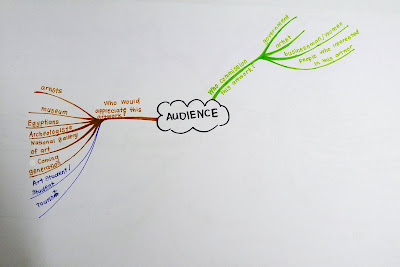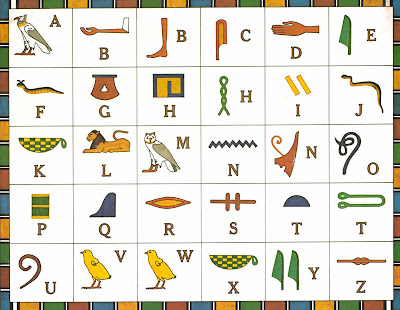 |
| Knight, Death and the Devil |

Assignment 3: Art Appreciation & Criticism
Part I - Description
The artwork ‘Knight, Death and the Devil’ also known as ‘The Rider’ was painted by a Renaissance painter who named Albrecht Durer in the year of 1513. It is an engraving carved on a copper plate. The size of the artwork is 25.0 cm height with 19.2 cm width.
Objects we see in the artwork from the top part is a castle, it is small and slightly blurred, and the mountain located under the castle. Slightly downward is the trees and rocks, the trees do not have any leaves on the branches and the size of the rocks are big.
In the middle part of the artwork we can see three characters. From the left is the Death, an old man with beard and his wearing a crown of snakes, the snakes encircling his head and neck, and his hand holding an hour glass and riding a horse. At the right is the Devil, a pig-snouted liked creature with horse legs, and a horn on its head and the horn is in a crescent shape, and he is standing and holding a spear. In the middle is a Templar knight, his riding on a horse with a sturdy posture, he equipped with a set of metal armor and a sword likely to be a claymore, and his right hand is holding a lance and wrapped with fox tail at the end of the lance.
At the bottom part of the artwork, from the left is a skull on a tablet, there are some unknown word on the tablet. The dog is located at the middle, it is in running pose and following the knight, it is a hunting dog. At the left is a lizard under the dog, moving to the left hand side direction.
In this artwork we can found many types of element of art applied in it. In terms of colour for the overall artwork, it is just grey tone or monochromatic. In element of shape, the shapes mostly we can found in the artwork are organic shapes such as the horse, dog, knight and etc. For the geometric shape will be the sword, tablet, lance and etc. For the element of value, we can found it at the knight, devil, death and etc. to shows the 3D value of the object. Furthermore, there are two types of line can be found in this artwork which is the curve and straight lines, the curve lines can be found at the fur of the dog, horse and etc. and for the straight lines can be found at the lance, sword and etc. For texture, simulated texture can be found at the armor of knight which seems to be hard.
Part II – Analysis
There is several type of principle of organization applied into this artwork. Firstly is principle of proportion, the accurate proportion of the knight and the horse is the biggest proportion in the artwork because it covers almost three quarters of the artwork. Second is the principle of rhythm, the irregular value from the background to the foreground which is from light to dark has shown a flow or a movement to the artwork. After that is the principle of space, the atmospheric perspective formed a depth to the artwork which is use environment to show distances, the castle is the background and it looks small and blur while the rock is the middle ground and it looks big and the knight and horse is the foreground which is the biggest and clearest. Furthermore, the principle of balance, vertical approximate balance formed in the artwork because the weigh for the left and right are almost the same while the knight became a divider in middle. Follow by principle of scale, the size of the knight and horse is much bigger than the devil and death which placed behind the knight. Another principle is movement, there is a psychic line formed between knight with the devil, death and dog when they look at the knight. Besides that, there is an implied line formed on the fur of the dog which showing the fur flowing to backward and there are many crisscross line can be found all over the artwork. In addition, implied shape can be found on the knight and horse which likely to form a triangle shape and it also form a contrast between the knight and horse which is the knight in vertical shape and the horse in horizontal shape. Lastly, principle of elaboration, we can see that there are many details in every single object in the artwork especially the horse and knight have many details in it.
The artwork is an engraved carved on the copper plate. He used his burin to render differences in texture and tonal values, meticulous rendering of myriad details the knight’s armor and weapon, horse’s anatomy, texture off loathsome features of death and the devil, the rock forms and rugged foliage.
In my subjective view on this artwork, my first impression when I look at this artwork it create a mood of serious to me because of the expression of the knight looks serious and fearless even though there are two devil creatures behind him and with the grey tone colour of the artwork looks even more serious because it do not have any other colorful colours to distract our eyes from the knight. Besides that, it also gave a feeling of war, because the knight wearing the full set armor with lance and sword as if he is well prepared to go to war already. As addition, the artwork also give a feeling of horror because of the devil, death and skull they make me feels like they are going to do something bad to the knight and they are unusual to appear in our world too.
Part III – Judgment
‘Knight, Death and the Devil’, the artist intention to create this artwork is to highlight the importance of morality during the medieval. Besides that, he is trying to emphasize Christianity with the help of the Christian Knight. As addition, this artwork does not contain any overtly political message.
This artwork is imitating an event which likely to be a crusade and also to show a journey of life which surrounded by the devil and death.
Besides that, this artwork also fulfilled the aspect of emotionalism because every objects that in the artwork has their own symbolization. For the knight, he is actually a Templar knight, and he also symbolizes faith and a soldier of God and he also used to represent crusade because Templar knight only fight during the crusade. Second is the death, it depict in this way may be influenced by the Greek mythology creature of Medusa, her hair of snakes are symbolic of the natural cycle of birth, death and rebirth, this could be why the artist depict the death with snakes hair. Third is the devil, the artist depict it in this way could be influenced by the Greek mythology creature Baphomet which symbolize temptation, immoral behavior and secular desires. Besides that, the castle which located on top of the artwork symbolizes God and kingdom of heaven. On the other hand, dogs are used in Renaissance artworks as iconography for the watchful and loyal so the dog could be interpreted that the Knight will stay loyal to his cause and his moral beliefs and the lizard used to symbolize religious zeal. The hour glass holding by the death could be a reminder of time and also symbolizes mortality.
Furthermore, this artwork also consists of the criteria for functionalism because it talks a lot on Christianity and morality which actually emphasizing the importance of religion. Besides that, it is also an allegory on Christian Salvation.
Part IV – Audience
No one commission Albrecht Durer to produce this artwork and it is created while he was in the service of the Emperor Maximilian. People who will appreciate this artwork could be historian or student who study about religion and history in the medieval age, because this artwork talk about Templar knight, crusades that happened in middle age, and also Christianity and morality.
References
(n.d.). Retrieved Aug 15, 2011, from Medusa Analysis: http://medusa.plush.org/analysis.shtml
Adams, C. (2007). The Knight, Death and Devil. Retrieved Aug 2011, from The Durer Hypothesis: http://www.thedurerhypothesis.com/Knight,%20Death%20and%20Devil.html
Bowman, D. (2008). Knight Death Devil-Knight Templars. Retrieved Aug 2011, from Aiwaz Net: http://www.aiwaz.net/knight-death-devil-knight-templars/a12
British Museum. (n.d.). Albrecht Dürer, Knight, Death and the Devil, a copperplate engraving. Retrieved Aug 2011, from The British Musuem: http://www.britishmuseum.org/explore/highlights/highlight_objects/pd/a/albrecht_d%C3%BCrer,_knight,_death.aspx
Grand Lodge. (2007). Myth of the Baphomet. Retrieved Aug 15, 2011, from Grand Lodge of British Columbia and Yukon: http://freemasonry.bcy.ca/anti-masonry/baphomet.html
GSTT Co. (2001). Albrecht Durer . Retrieved August 2011, from German Toasting Glasses: http://www.german-toasting-glasses.com/information_library/albrecht_durer_chalice.html




















